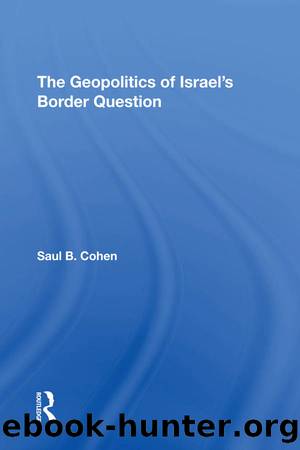The Geopolitics of Israel's Border Question by Saul B Cohen

Author:Saul B Cohen [Cohen, Saul B]
Language: eng
Format: epub
Tags: Middle Eastern, Social Science, Political Science, World, Regional Studies
ISBN: 9781000301823
Google: W6vMDwAAQBAJ
Goodreads: 53146260
Publisher: Routledge
Published: 2020-01-28T00:00:00+00:00
Defensive Depth
The narrowness of Israelâs central coastal plain and the intrusion of the Latrun salient at the conjuction of the Shephela and the western edge of the Jerusalem Corridor present tactical liabilities that call for boundary adjustment (or some unique condominium zone of assimilation in which Israel would have full military control and settlement rights) (see Figure 4). Another aspect of this problem has to do with those sections of the Green Line where Israeli Arab villages adjoin the West Bank and have a potential for destabilization. How to arrange territorial adjustments and still provide for a West Bank entity that has rational territorial limits is a complex question. Certainly a boundary that follows Gush Emunim settlements on the ridge tops of Samaria 10 to 15 km. east of the Green Line would leave little territorial integrity to a West Bank entity. On the other hand, even modest territorial adjustments up to several kilometers eastward into the SamarÃan piedmont in a few key areas could enhance Israelâs security. Boundary adjustments would also permit unification of some Arab villages and lands on both sides of the Green Line, and allow West Bank Arabs of the SamarÃan foothills to maintain full access to employment and markets in Israelâs coastal plain.
It is especially important to Israel from the standpoint of defensive depth to incorporate the Latrun wedge, including the former no-manâs land opposite Lod. Extending from this western sector, the Corridor has to be widened all along the north so that Jerusalem will not be dependent on one major road for its lifeline. The highway link from Lod through Emeq Ayyalon to Givon, together with settlements in this area, anticipates the development of a security zone on the northern side of the Corridor around which a subsequent boundary can be delimited. Broadening the Corridor in the south via the Etzion Bloc permits another highway link to Jerusalem running from Kiryat Gat to Beit Guvrin to Efrat east of the Bethlehem road, and north to the southern edge of the capital. With all of these changes, the Corridor at its eastern end would run from Givon and Atarot Airport in the north to Gush Etzion and Efrat in the south, a distance of 25 km. All told, such a broadened Corridor would have substantial defensive depth.
While a number of Arab villages would have to be included within the new Israeli territory, Jerusalemâs security needs override the objections of this Arab populace to being annexed. Moreover, Jerusalem and the Israeli coastal plain provide the major job opportunities and markets for these villages.
Another area that provides Israel with surveillance space is the nearly empty eastern Judean Desert overlooking the northwestern Dead Sea. This provides oversight of the road from Jerusalem to Jericho and the Allenby Bridge. The area, a strip 10 km. wide, also offers an important strategic base for Israeli armor to defend the road.
Download
This site does not store any files on its server. We only index and link to content provided by other sites. Please contact the content providers to delete copyright contents if any and email us, we'll remove relevant links or contents immediately.
Cecilia; Or, Memoirs of an Heiress — Volume 1 by Fanny Burney(32023)
Cecilia; Or, Memoirs of an Heiress — Volume 3 by Fanny Burney(31437)
Cecilia; Or, Memoirs of an Heiress — Volume 2 by Fanny Burney(31382)
The Great Music City by Andrea Baker(30641)
We're Going to Need More Wine by Gabrielle Union(18607)
All the Missing Girls by Megan Miranda(14602)
Pimp by Iceberg Slim(13718)
Bombshells: Glamour Girls of a Lifetime by Sullivan Steve(13667)
Fifty Shades Freed by E L James(12886)
Talking to Strangers by Malcolm Gladwell(12816)
Norse Mythology by Gaiman Neil(12789)
For the Love of Europe by Rick Steves(11333)
Crazy Rich Asians by Kevin Kwan(8861)
Mindhunter: Inside the FBI's Elite Serial Crime Unit by John E. Douglas & Mark Olshaker(8665)
The Lost Art of Listening by Michael P. Nichols(7125)
Enlightenment Now: The Case for Reason, Science, Humanism, and Progress by Steven Pinker(6852)
The Four Agreements by Don Miguel Ruiz(6284)
Bad Blood by John Carreyrou(6255)
Weapons of Math Destruction by Cathy O'Neil(5801)
